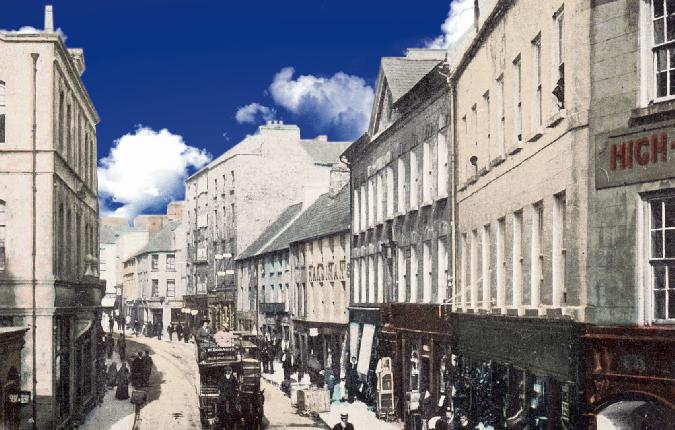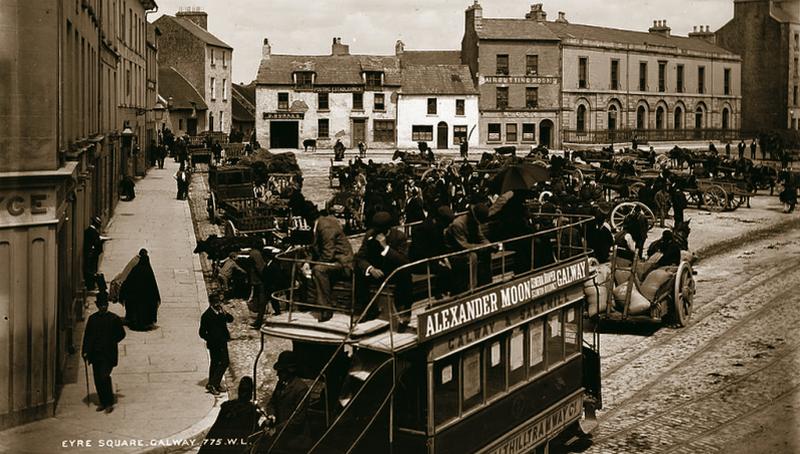Archive News
Portumna close in on club hurling history

Date Published: {J}
JOB done. We have become used to Portumna hurlers producing awesome displays in All-Ireland Club semi-finals, but last Sunday in Parnell Park wasn’t one of them. Of course, there is no arguing with a comprehensive 12 points victory over a battling Dunloy outfit, but the reigning champions certainly weren’t as slick or as sharp as we have come to expect of them at this time of year.
In reality, it’s probably a good thing. Portumna knew they didn’t have to peak for their clash with the admirable Antrim men and have probably kept something in the locker for next month’s mouth-watering All-Ireland final against Ballyhale Shamrocks.
That March 17 showdown has all the ingredients to be an epic as Johnny Kelly’s men close in on hurling history and a third consecutive Tommy Moore Cup.
That’s a challenge for another day and Portumna’s less than spectacular effort against Dunloy could be a blessing in disguise in the build up to the decider. There may be no obvious signs of any significant wear and tear in their ranks having been virtually hurling all-year around over the past seven seasons, but Portumna can’t be going out and blowing teams away every day. Serving up consistent high intensity performances do eventually take their toll and the title holders are probably aware of it.
Mind you, when it was put up to them in the second-half at Parnell Park, Portumna’s response will have assured their supporters that the hunger and ambition remains intact. Four unanswered points, including a spectacular effort from wing back Kevin McKeague, had brought Dunloy to within 1-11 to 0-9 on the scoreboard and it also took a piece of smart goalkeeping from Ivan Canning and superb defending by Ollie Canning in the same incident subsequently to maintain that advantage.
With Dunloy deploying wing forward Paul Shields as an extra defender, Portumna were finding it difficult to open up the opposition rearguard though the tactical bunching couldn’t prevent Joe Canning from expertly putting Ciaran Ryan in the clear for a tonic goal in the second quarter. They led 1-10 to 0-5 at the interval with Kevin ‘Chunky’ Hayes and half-back Peter Smith landing excellent points despite the very bare surface which would hardly have suited the long-time unbeaten champions.
A pointed Canning free stretched Portumna’s advantage early in the second-half, but Dunloy proceeded to enjoy their best period of the match and having paired back the lead to five points and backed by the elements, it briefly appeared that Leo Smith and company were in trouble. Typically, they upped the ante and with Joe Canning’s switch to the forty causing a bit of panic in Dunloy’s ranks, allied to Andy Smith neat point-taking on the left wing, they began to pull away again.
Overall, a rock-solid effort from Portumna with centre back Micheal Ryan again emerging as one of the team’s most influential performers. Behind him, Ollie Canning never put a foot wrong and the squad have clearly left something to work on ahead of the final. The re-availability of Niall Hayes will increase their options and it is only reasonable to assume a far more vigorous effort in Croke Park.
As anticipated, Ballyhale came through – just about – their semi-final clash with Newtownshandrum in Thurles on a day the rival goalkeepers excelled. Initially, it looked like the Kilkenny men were going to comfortably justify their favourites’ tag with Henry Shefflin doing a fair bit of damage up front. They led 0-13 to 0-10 at the interval, but the Cork champions came roaring back into the contest on the resumption.
The repeated sight of Cathal Naughton, admittedly hurling’s answer to Usain Bolt, careering through the Ballyhale defence will not have gone unnoticed by Portumna whose pace and movement had bewildered the same opposition in last year’s All-Ireland semi-final. There is no doubt that Ballyhale are dangerous in attack, but a big question mark still hangs over their rearguard. In short, Portumna have the better balanced team.
DEFINING GAME
IRELAND’S horrendous record against the French in Paris – now one win in 39 years – took a turn turn for the worse last Saturday. Not alone were the reigning Six Nations champions beaten, but they were beaten out of sight. There is no arguing with a 33-10 scoreline and several of the team’s great servants looked tired men long before the finish.
There is absolutely no doubt that this Ireland squad hit their peak performance level last season and a first Grand Slam triumph in over 60 years was no more than Brian O’Driscoll and his team-mates deserved. This squad of players have given us many great days, but they can’t go on forever. Hayes, O’Connell and Wallace are starting to wilt in the pack while O’Gara’s best years are behind him too.
Sure, they will lift it for their upcoming confrontation against England at Twickenham, but we can forget about Ireland becoming World champions. Frankly, the mercurial French could have won by more as tries from Servat, Jauzion and Poitrenaud, not forgetting quality drop goals from Parra and Michalak, were the high points of a devastating performance. Ireland simply couldn’t cope with France’s aggression and brute force – the only consolation is that they won’t be running into such high quality opposition for the rest of the tournament.
For more, read page 53 of this week’s Connacht Tribune.
Galway in Days Gone By
The way we were – Protecting archives of our past

People’s living conditions less than 100 years ago were frightening. We have come a long way. We talk about water charges today, but back then the local District Councils were erecting pumps for local communities and the lovely town of Mountbellew, according to Council minutes, had open sewers,” says Galway County Council archivist Patria McWalter.
Patria believes we “need to take pride in our history, and we should take the same pride in our historical records as we do in our built heritage”. When you see the wealth of material in her care, this belief makes sense.
She is in charge of caring for the rich collection of administrative records owned by Galway County Council and says “these records are as much part of our history as the Rock of Cashel is. They document our lives and our ancestors’ lives. And nobody can plan for the future unless you learn from the past, what worked and what didn’t”.
Archivists and librarians are often unfairly regarded as being dry, academic types, but that’s certainly not true of Patria. Her enthusiasm is infectious as she turns the pages of several minute books from Galway’s Rural District Councils, all of them at least 100 years old.
Part of her role involved cataloguing all the records of the Councils – Ballinasloe, Clifden, Galway, Gort, Loughrea, Mountbellew, Portumna and Tuam. These records mostly consisted of minutes of various meetings.
When she was cataloguing them she realised their worth to local historians and researchers, so she decided to compile a guide to their content. The result is For the Record: The Archives of Galway’s Rural District Councils, which will be a valuable asset to anybody with an interest in history.
Many representatives on these Councils were local personalities and several were arrested during the political upheaval of the era, she explains.
And, ushering in a new era in history, women were allowed to sit on these Rural District Councils – at the time they were not allowed to sit on County Councils.
All of this information is included in Patria’s introductory essay to the attractively produced A4 size guide, which gives a glimpse into how these Rural Councils operated and the way political thinking changed in Ireland during a short 26-year period. In the early 1900s, these Councils supported Home Rule, but by 1920, they were calling for full independence and refusing to recognise the British administration.
“I love the tone,” says Patria of the minutes from meetings. “The language was very emotive.”
That was certainly true of the Gort Rural District Council. At a meeting in 1907, following riots in Dublin at the premiere of JM Synge’s play, The Playboy of the Western World the councillors’ response was vehement. They recorded their decision to “protest most emphatically against the libellous comedy, The Playboy of the Western World, that was belched forth during the past week in the Abbey Theatre, Dublin, under the fostering care of Lady Gregory and Mr Yeats. We congratulate the good people of Dublin in howling down the gross buffoonery and immoral suggestions that are scattered throughout this scandalous performance.
For more from the archives see this week’s Tribunes here
Archive News
Galway have lot to ponder in poor show

Date Published: 23-Jan-2013
SLIGO 0-9
GALWAY 1-4
FRANK FARRAGHER IN ENNISCRONE
GALWAY’S first serious examination of the 2013 season rather disturbingly ended with a rating well below the 40% pass mark at the idyllic, if rather Siberian, seaside setting of Enniscrone on Sunday last.
The defeat cost Galway a place in the FBD League Final against Leitrim and also put a fair dent on their confidence shield for the bigger tests that lie ahead in February.
There was no fluke element in this success by an understrength Sligo side and by the time Leitrim referee, Frank Flynn, sounded the final whistle, there wasn’t a perished soul in the crowd of about 500 who could question the justice of the outcome.
It is only pre-season and last Sunday’s blast of dry polar winds did remind everyone that this is far from summer football, but make no mistake about it, the match did lay down some very worrying markers for Galway following a couple of victories over below par third level college teams.
Galway did start the game quite positively, leading by four points at the end of a first quarter when they missed as much more, but when Sligo stepped up the tempo of the game in the 10 minutes before half-time, the maroon resistance crumbled with frightening rapidity.
Some of the statistics of the match make for grim perusal. Over the course of the hour, Galway only scored two points from play and they went through a 52 minute period of the match, without raising a white flag – admittedly a late rally did bring them close to a draw but that would have been very rough justice on Sligo.
Sligo were backable at 9/4 coming into this match, the odds being stretched with the ‘missing list’ on Kevin Walsh’s team sheet – Adrian Marren, Stephen Coen, Tony Taylor, Ross Donovan, David Kelly, David Maye, Johnny Davey and Eamon O’Hara, were all marked absent for a variety of reasons.
Walsh has his Sligo side well schooled in the high intensity, close quarters type of football, and the harder Galway tried to go through the short game channels, the more the home side bottled them up.
Galway badly needed to find some variety in their attacking strategy and maybe there is a lot to be said for the traditional Meath style of giving long, quick ball to a full forward line with a big target man on the edge of the square – given Paul Conroy’s prowess close to goal last season, maybe it is time to ‘settle’ on a few basics.
Defensively, Galway were reasonably solid with Gary Sice at centre back probably their best player – he was one of the few men in maroon to deliver decent long ball deep into the attacking zone – while Finian Hanley, Conor Costello and Gary O’Donnell also kept things tight.
For more, read this week’s Connacht Tribune.
Archive News
Real Galway flavour to intermediate club hurling battle in Birr

Date Published: 23-Jan-2013
images/files/images/x3_Courthouse.jpg










